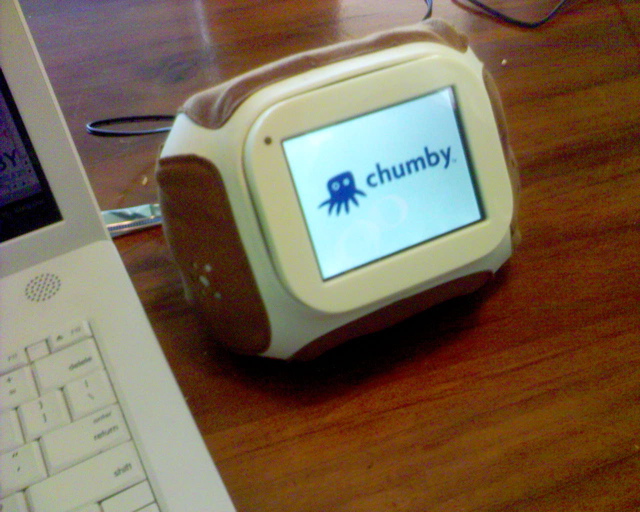I'm way overdue for a comment on my Chumby, the special digital friend I picked up at Foo Camp. The younger boy and I have registered and named (he picked "Brownie") our Chumby and done a little investigating.
This device is a minimum six months away from launch, and the one we have is definitely alpha hardware - the "squeeze" interface (which brings up a configuration screen) and the touch-screen work fitfully (my son has a better touch with it than I do) and it occasionally freezes.
I now have a much clearer idea of what it is and how it works. One key thing to understand is that the Chumby doesn't download applications, it subscribes to them, in the form of Flash widgets hosted on the Chumby website (although it has a USB port, the default is for it to connect to the site via WiFi.). It's a thin client in a fat little body:

At present, it subscribes in a fairly inflexible way: you can load up as many widgets as you like, the Chumby will cycle through them one after another, with the running time for each defined by the individual developer.
It needs the ability for users to group widgets into profiles - so you'd just have the alarm clock when you wanted a clock, and maybe three or four at other times. You can very easily delete widgets direct from the Chumby, but you need an internet-connected computer to re-load them.
This thing needs content. It's been styled as a new-age bedside alarm clock, and the various clock widgets work fine. The Digg and Slashdot headline services are pretty nice too, but what really gave us a glimpse of its potential were the webcam widgets. Sitting watching Shamu the orca swim around a pool in San Diego at one frame a second was a surprisingly vivid experience.
The logo design and UI graphics are by Susan Kare, the legendary graphic artist responsible for the original Mac UI icons and fonts, and they're gorgeous. Chumby CEO Steve Tomlin told me she was a friend - some friend to have on call!
The Chumby doesn't handle video yet, although this forum thread suggests that that will come when they've settled on a processor (the current one is a Freescale MX21 ARM9). Video decoding will be handled by a dedicated piece of hardware to be added by the time of commercial release. It seems that various other capabilities, including VOIP, will be possible as the project goes along.
The Chumby blog suggests that application ideas have been pouring in from interested observers, which is what the makers intended when they published all the specs and invited in hackers.
I have an interview with Tomlin and his co-creator Bunnie Huang, but I just haven't had time to transcribe and edit it. Best do it soon, huh?
Meanwhile, some fairly striking internet speed tests from Juha in San Francisco. Access to NZ-based servers is almost criminally bad.
This is what's wrong with the American media environment. This week, every regional issue of Newsweek in the world carries a cover story called 'Losing Afghanistan', with a striking picture of a Taliban fighter brandishing a rocket-propelled grenade. Except for the American edition, which goes with a soft story on Annie Leibowitz ('My Life in Pictures').
And this is quite nice: The Guardian has a Quicktime VR (remember Quicktime VR?) panorama of Tony Blair delivering his last party conference speech as leader.